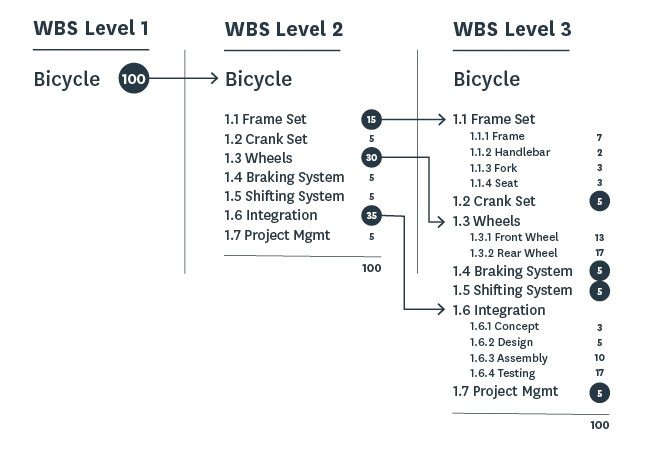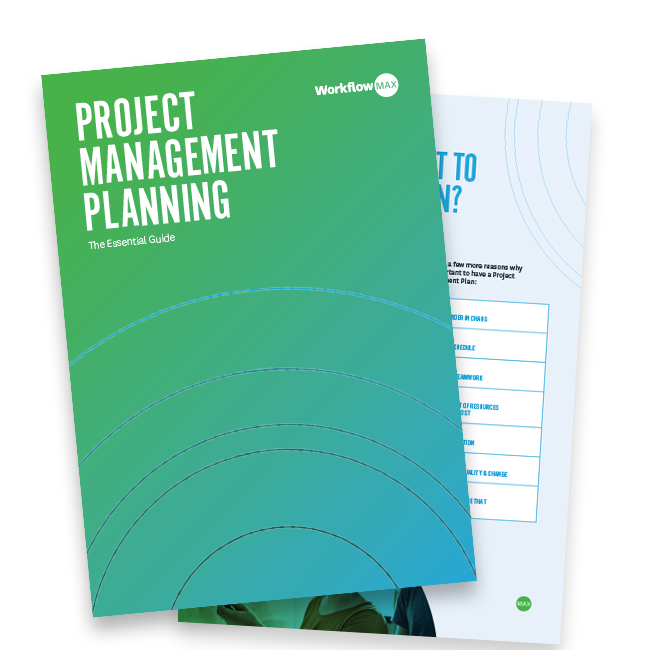What is a Project Management Plan?
The Project Management Institute (PMI) defines a Project Management Plan as a formal approved document that lays out the overarching strategy for how a project will be executed, monitored and controlled.
Planning is critical for any project’s success, but it does not exist in isolation. It’s part of the project management cycle, developed by the Project Management Institute and consists of five critical phases: conception and initiation, planning, execution, and closure.
The five project phases make up the life cycle of any project. Each phase should be tailored to meet the specific projects requirements. The phases of a project’s life cycle will define:
- What work must be accomplished
- What deliverables must be generated and reviewed
- Who must be involved
- How to control and approve each phase
Project managers need to think through these core areas before they embark on writing a plan. Understanding these areas will take a project from start to finish and help project manager’s identify what needs to be achieved before moving onto the next phase of a delivery.
A Project Management Plan is a living and breathing document, evolving seamlessly alongside the project. From the outset, break your Project Management Plan into clear parts. The PMP that you create should be accessible to all project members as it is the primary tool of communication.
Online cloud based project management software (like WorkflowMax), that can be accessed in or out of the office and tracks and centralises changes and amendments, offers many benefits and advantages for project management and planning.
Why is it important to have a project plan?
Project Management Plans organise and contain complex and interconnected threads of information. No single person can store and retain all the detailed elements of a large project. Perhaps you’re working on a project right now. A new website for your client, the rebrand you've been engrossed in, the slick new packaging campaign that's being rolled out next week, a series of layered corporate events. What links all projects is a multiplicity of threads. All projects require that things get done in a time saving and efficient way.
Here are a few more reasons why it's important to have a Project Management Plan:
- Creates order in chaos
- Creates a schedule
- Encourages teamwork
- Makes the most of resources and controls cost
- Manages integration
- Helps to manage quality & change
- Generates knowledge that can be used again
What are the benefits of online project management?
Most significantly —better, more sophisticated project tracking. With an online system, you’ll be able to track your projects phase-by-phase and understand the key variables that have an impact on profitability. But here are a few more advantages that online project management tools offer:
- Open client communication. Give your client a login and they can check on the status of the project or keep up with notes at any time. This minimises the need for extraneous meetings, so you have more time to get on with the project
- Real-time project transparency. A ‘live’ overview means that you always know exactly how a project is progressing and can align your team to work faster and smarter across the organisation
- Ability to work from anywhere. Stuck on the train in rush hour? Working from home? You'll still be able to keep an eye on your project from wherever you are. Any contractors or remote workers in your team can access it too, see updates and milestones, and track their own progress
- All in one place. No more annoying paper filing. You’ll be able to store documents, notes and even email conversations in one place.
How to Build a Project Management Plan
Let’s go back to the foundations of a house. You are about to lay these foundations now. But rather than using concrete, steel, or bricks and mortar you’re going to construct a plan made up of various written elements. This typically starts by setting goals. In the building phase the scope of the project is defined and a project management plan is developed. This involves identifying:
- Budget - what do you need or how much do you have to complete a project?
- Available human resources - who do you have on board to help?
- Timeframe - when does the project need to be completed?
The Project Management Plan is where you take a birds-eye view and hone down on the detail. But the project plan is not something you write and then never revisit. You will be going back to the plan, referring and revising it along the way.

Project Planning Stages
Generally there are eight to nine core elements that make up a good project plan. Here is an overview of each core element.
1. Identify and define the scope of the project
This is your hero statement or executive summary that will keep the project focused. It should be available to everyone working on the project. It is a written document that clearly lays out:
- Core aims and benefits of the project
- Primary objectives
- Deliverables
- Significant milestones
- Revision time and other allowances
- Closure
Of course the scope of the project may change over time, and the plan will need to be updated to reflect any changes. Particular attributes and quality specifications of the project should also play a part in this section. For example, describing the product or service performance criteria from a customer or client perspective. Project presuppositions should also be included, and grey areas clarified in the project scope. By following these basic principles the chance of a project going way beyond what was initially envisioned can be significantly reduced, in other words, you can restrict ‘scope creep’ from rearing its ugly head.
2. Break the project down
The project schedule is the tool that communicates what work needs to be performed, which resources of the organisation will perform the work and the timeframes in which that work needs to be performed. The project schedule should reflect all of the work associated with delivering the project on time. Without a full and complete schedule, the project manager will be unable to communicate the complete effort, in terms of cost and resources, necessary to deliver the project.
The building blocks of a project schedule start with a Work Breakdown Structure (WBS), an important project tool that organizes your team's work into manageable smaller parts. The WBS visually reflects the scope of the project in a simple diagram form that a project team can see and easily understand. A work breakdown structure is a bit like a map, guiding everyone to their final destination. You can start to create a work breakdown structure by identifying the most significant deliverables and then breaking these down into smaller sub-deliverables. The sub-deliverables are then further dissected until they can be assigned to a single person to action. In addition to visually presenting the project and breaking it down, a detailed WBS helps projects managers account for labor requirements and effectively distributes jobs and task. It is here that Project Managers can clearly see what human resources they require to complete the project. This is sometimes referred to as a ‘work package’. A good understanding of your work package helps to:
You can start to create a work breakdown structure by identifying the most significant deliverables and then breaking these down into smaller sub-deliverables. The sub-deliverables are then further dissected until they can be assigned to a single person to action. In addition to visually presenting the project and breaking it down, a detailed WBS helps projects managers account for labor requirements and effectively distributes jobs and task. It is here that Project Managers can clearly see what human resources they require to complete the project. This is sometimes referred to as a ‘work package’. A good understanding of your work package helps to:
- Create to-dos for specific units of work
- Allocate costs
- Track financial progress
- Keep an eye on staff performance
It is important to distinguish here that although often used interchangeably, the terms "project planning" and "project scheduling" are two entirely different pieces of the project management plan. Each plays a role in getting a project to completion on time, however, the project plan serves as the master blueprint whereas the project schedule nails down the details of specific tasks within the project plan.
3. Detail Milestones
Milestones are the toolbox of successful project management. They help you identify high-level goals that need to be met throughout the project. Milestones act as reminders. When should a project start and end? Is there a need for external review or input and budget checks? In many instances, milestones do not impact project timeframes. Instead, they focus on major progress points that must be reached to achieve success. Detailing and using milestones in your Project Management Plan also has the following advantages:
- Helps to accurately determine whether your project is on schedule or not
- Allows for forecasting and troubleshooting
- Provides a wider view of critical time-frames
Your project management software can help you track important dates - for example in WorkflowMax you can set milestones and receive notifications for when these are due.
4. Resource Planning
A Resource Plan summarises the level of resources needed to complete a project. A properly documented Resource Plan will specify the exact quantities of labour, equipment and materials needed to complete your specific task or project. By creating a comprehensive Resource Plan, you can ensure that all of the resources needed to complete the project are identified. By implementing proper Resource Planning practices, it also helps you with budgeting and forecasting project expenditure.
5. Set Project Budgets
Before any project begins, the project manager might face the largest challenge of anyone on the team, determining the project's budget. They will need to decide the baseline budget that is set at the beginning of the project, and as the project forges ahead, continue to monitor and adjust the budget according to actual costs incurred during the course of the project.
The project budget serves as a guideline and includes all costs for a given undertaking by a company or a team within a company. Calculated costs include the likes of human resource costs; the cost of materials specific to the project; office resources and consumables. With so many variables, the project budget is not intended to resemble an invoice but is a guideline to help keep the team on task and the client aware of the ongoing costs. The project manager, along with a budgetary committee or lead developer, calculates these potential costs.
In reality the budget is not often a constant. Since incidentals do come up during any project, the budget is often a moving target. It is essential for the project manager to continually monitor and report any changes in budget due to variables such as unexpected meetings and travel, problem-solving and overtime to meet deadlines.
6. Create a Timeline
Always incorporate a timeline into Project Management Plans. A visual timeline may be helpful, so everyone knows exactly what to expect. The more detail your timeline contains the more effective it will tend to be. The timeline will protect you and your project from scope blow-out.
Timelines are commonly used by large companies and small businesses principally because they help to:
- Increase productivity
- Enhance communication
- Assist with forecasting
- Help track results
Timelines keep teams on track, and provide a visual reference for starting and finishing specific tasks. They are a visual overview of milestones and other key dates. Timelines are also thought to reduce misunderstandings. Creating a robust timeline for your project allows all types of stakeholders access to the same, critical information. This promotes optimum work flow, maximized productivity and overall project success.
7. Think about your Communication Strategy
If your project involves outside stakeholders it’s particularly important to have a communication strategy in place. A good communication strategy will set the tone of all project communication and create a schedule of when to communicate with team members, and outside stakeholders. A project management communication plan defines how critical information will be delivered throughout the project, by who, and at what frequency. A good project communication plan should:
- List project stakeholders upfront
- Define communication channels by preference and priority level
- Give structure to fall back on when client/customer communication is faltering
Communication is critical for maintaining good relationships with clients and other teams members. Like project planning, it’s important to set expectations from the outset so that the project team and client stakeholders are aware of their responsibilities. Project communication plans are often overlooked—but they shouldn't be. A project communication plan will ultimately help project managers to ensure there is a solid, shared understanding of how and when to communicate.
8. Risk Management
Think about and document all foreseeable risks and potential problems. The risk management section of your PMP should not only detail potential risks but put in place preliminary ways to manage, contain and reduce risk. Common risks include:
- Unrealistic time-frames
- Unrealistic cost estimates
- Sudden changes with clients or customers
- Budget cuts
- Changes in staffing and resource
Project risk management should define, analyse and respond to any risk that arises over the life cycle of a project. This will assist the project to remain on track and meet its goal. Risks are problems that haven't eventuated. If identified risks become realities, they are then referred to as ‘issues’. Risk management identifies, categories, prioritise and plans for risks before they become issues.
9. Wrapping up the project
What happens when your project is finished? Are there details that need to be planned for in order to wrap everything up smoothly? This is called closure. Closure represents the completed project. Here is list of things to consider when planning for closure.
- Termination of contractors hired to work specifically on the project
- Recognition of valuable team members
- A small event to thank the people who participated
- Preparation of final budgets and reports
- Collecting, storing or removing any documents or project collateral
After a project is complete, a project manager often holds a final meeting to assess what went well in the project and to identify project failures. It is especially helpful to understand lessons learned so that improvements can be made for future projects.

Which project management software should you choose?
Here are some questions (and answers) to think through before deciding on software.
Q Is it online and cloud-based?
A In cloud based systems, data is always up to date and accessible from anywhere, across devices.
Q Are there education/support resources available?
A Look for software that has a good support page, online training modules, education videos or self paced courses.
Q Does it integrate with other softwares?
A If you’re using Xero for your accounting, your project management system should integrate with existing platforms. WorkflowMax integrates with over 30 world-class add-ons and has seamless integration with Xero. You can customise it and make it work for you.
Happy planning!









